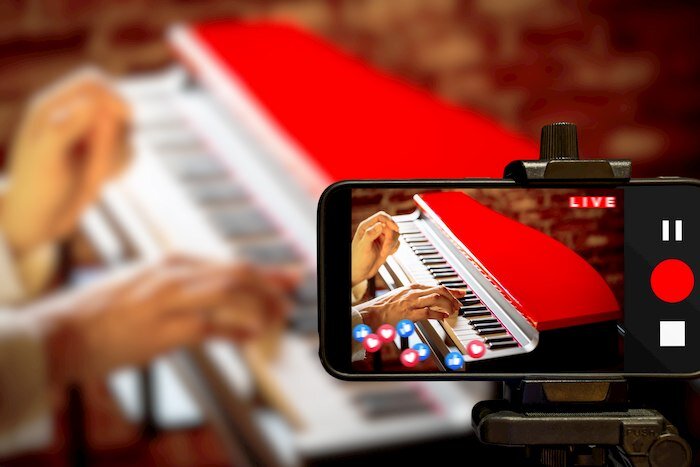Online piano lessons - a simple guide
/Online piano lessons are interactive and a great way to learn to play the piano. In this guide, we will take you through how they work, what you need, and the benefits of virtual lessons. We also explain the pros and cons of free piano resources online.
If you are considering online piano lessons, why not take advantage of our free first online piano lesson to see if it’s right for you?
Can I take piano lessons online and what will I need?
Piano lessons adapt well to an online platform, so it won’t take long for you to master your pianist skills. To get the most out of learning online, there are a few things that you will need in preparation for your lesson.
To have online piano lessons, you will need:
A keyboard or piano - read our article regarding which piano to buy
A desktop, laptop, tablet or smartphone - or a combination of the two
An internet connection - 60mbps and above is preferred
An email account - Gmail is preferred as your teacher will use this to send you a link to the video stream where the lesson will be
To have downloaded your chosen video streaming app (only necessary for phone or tablet)
You have two options regarding the camera setup:
A single-camera:
This would involve a singular camera that would either be placed in front of you or to the left of you. Of the two, in front is the preferred option.
In front: smartphone or tablet
To the side: desktop, laptop, smartphone or tablet (however a phone or tablet will need to be propped up)
Two cameras:
One would be placed in front of you and then a second one either above you or to the left of you. Of the two, above is the preferred option.
In front: smartphone or tablet
Above: smartphone
To the side: desktop, laptop, smartphone or tablet (however a phone or tablet will need to be propped up)
How do online piano lessons work?
To decide if online piano lessons will suit you, first, you’ll want to know how they work. A good and structured online piano lesson will consist of three parts; review, setting new work, and teaching you how to practice. Let’s explore these in more detail.
Review
The online piano lesson provides opportunities for numerous camera angles. This gives the piano teacher an unrivalled view of how you have done in your practice session.
Setting new work
Your teacher will have set up several different camera angles so student has a clear view of what the teacher is modelling. This offers the student excellent insight into the work that has been set.
Teaching you how to practice
Once you have been taught the required material, you will have to practice at home. Your teacher will be able to write up the lesson material and practice requirements. This will give you a great reference point the next time that you sit down to practice.
As you can see, there are several positive aspects of online piano lessons which will improve your ability to learn. You will also be much nearer to the kettle and biscuit tin if the need takes you.
Can I learn piano online for free?
There are many places to learn the piano online for free; however, each of them has its pros and cons. Learning anything requires accurate information, which is described to you clearly, taking into account your needs and goals.
If the information given to you is accurate but you misunderstand, then you could run into problems. You might end up developing a habitual feeling that the way you play is correct, even if it isn’t. This is why it’s always good to get feedback.
A piano teacher is much more than a provider of information. A good teacher provides the learner and the parents, with the support and insight into how the process is going and what can be done to improve it.
A great teacher will also give you the flexibility to change the path of learning when required. I regularly adapt my goals within the lessons if I feel it’s time for the student to move on. Sometimes, remaining on the same piece for too long is detrimental to the progress of the individual.
Although there are many free courses and platforms online, which have a wealth of information, every single student requires different approaches and a teacher is the best way to offer you that flexibility.
All students respond in varying levels of success to four different approaches to learning:
Kinaesthetic (movement)
Visual
Oral (spoken)
Aural (listening)
All learners have strengths as well as weaknesses and any learning needs to be reinforced with positive feedback, alongside solutions to any problems which may arise. Having a piano teacher who can adapt to your needs is the best way to ensure that your path of learning is as efficient as possible.
Although platforms such as YouTube are excellent when you know what to look for, knowing the right terms to search for in the first place is very difficult. To save money, perhaps you should take a short set of lessons to get started and understand what you want to look for. Although you cannot beat regular (weekly) lessons, this would be the next best thing.
Free piano lesson apps
With such a wealth of piano apps out there, it is useful to incorporate these into piano lessons. In fact, it’s very rare that I hold a piano lesson without one. Here is a list of some of my favourite apps that I use during my piano lessons.
Flash note Derby
This app is a fantastic way to teach both children and adults how to recognise where the notes are on an enjoyable but competitive platform. If you get a note correct, your horse goes ahead. If you get one wrong, the other goes ahead. There is jovial booing and cheering with fireworks for victories. There’s even a winter format with reindeer racing.
Here’s a link to download Flash note Derby in the Apple App Store.
Metrotimer
Although there is a wealth of metronomes out there, Metrotimer is my go-to. Very easy to use. It has multiple time signatures, a light to help keep in time, etc… and most importantly, it’s free.
Garageband
The DAWs (Digital Audio Workstations) of today are creeping into the land of the smartphone. Garageband, Apple’s native music-making program, is available in app format. You can program drums, bass lines, record audio from your phone’s microphone, use third party plugins and more. On top of that, there are also onboard effects that you can use.
All of the above can be shared with a third party via the present screen function of your chosen video streaming app.
Hopefully, this list of apps will be a useful addition to your piano lessons. If you need any help getting set up, please let me know.
How to find out more about online piano lessons
Here at PLUK, we have a number of highly experienced and trained online piano teachers who run courses every week.
Whether you’d like to book an online lesson or just ask a few questions first, please get in touch by emailing me (Kevin Matthews) on contact@pianolessonsuk.co.uk and I’ll be happy to help. Alternatively, you can call 01172 510011.
Written by Kevin Matthews - Director at PLUK.


